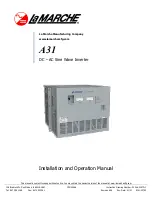
Chapter 2
Hardware Overview
NI PCIe-1427 User Manual
2-4
ni.com
Multiple-Tap Data Formatter
Many digital cameras transfer multiple taps, or pixels, of data
simultaneously to increase the frame rate of the camera. However, the data
in each tap may not be transferred in the traditional top-left to bottom-right
direction. Also, the taps may not transfer data in the same direction.
The multiple-tap data formatting circuitry on the NI 1427 can reorder the
data from multiple taps. The data from each tap can be independently
scanned either from left-to-right or right-to-left and top-to-bottom or
bottom-to-top.
Note
For your convenience, data reformatting instructions for these cameras have been
preprogrammed into the camera files.
Trigger Control and Mapping Circuitry
The trigger control and mapping circuitry routes, monitors, and drives the
external and RTSI bus trigger lines. You can configure each trigger line to
start an acquisition on a rising edge or a falling edge. You also can drive
each line asserted or unasserted as a digital I/O line. You can map pulses
from the high-speed timing circuitry or the NI 1427 status signals to these
trigger lines. Seven RTSI bus triggers and four external triggers—all of
which are programmable for polarity and direction—are available for
simultaneous use. Additional I/O is available with the NI Camera Link I/O
Extension Board. Refer to the
Using the NI 1427 with the NI Camera Link
I/O Extension Board
section of Chapter
3
,
Signal Connections
, for
information about the I/O functionality of the NI 1427 when used with the
NI Camera Link I/O Extension Board.
Individually configure the four external triggers in MAX as single-ended
I/O lines or, alternatively, as isolated or RS-422 input only lines. You can
configure the four external triggers in any combination of single-ended I/O
or input only lines. Table 2-1 lists the configuration options available for
each trigger source.
Artisan Technology Group - Quality Instrumentation ... Guaranteed | (888) 88-SOURCE | www.artisantg.com
















































